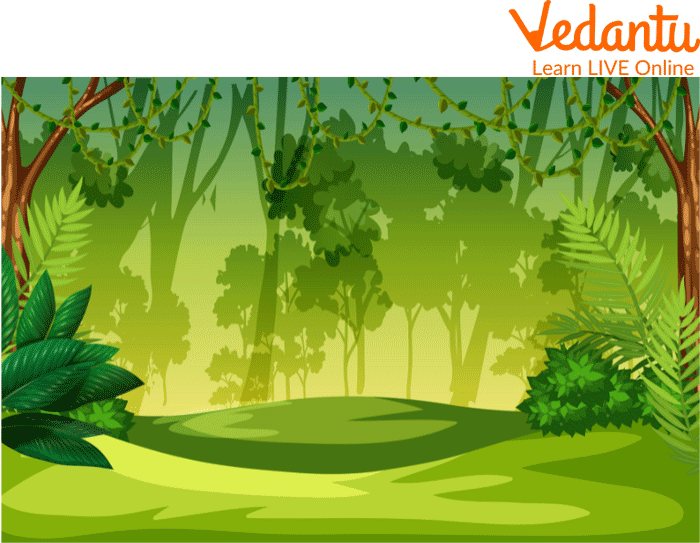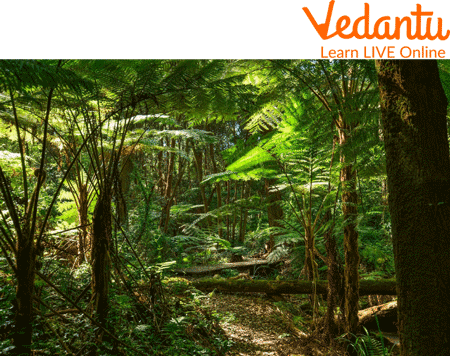




Types of Jungles and Unique Features Explained
The word jungle came from a Sanskrit word, “jaṅgala”. It means “rough and arid”. A jungle may be land or area with a particularly dense quantity of vegetation. This dense forest of vegetation includes several trees and plants found in tropical climates. They're also home to high biodiversity and many unique species but are also some of the most fragile ecosystems on Earth. A jungle appears overgrown and is sometimes in a particularly hot part of the world with loads of rainfall.
Let’s now see some interesting facts about the jungle, jungle habitat, and much more.
What is a Jungle?
A jungle may be a forest thick with trees, different plants, and animals. Jungles are a little dangerous; that is what people mean once they say, "It's a jungle out there!" Jungles are thick tropical forests full of life, such as birds, insects, reptiles, monkeys, and often gorillas and other animals.

Jungle
What Makes a Jungle?
The jungle is far-famed for its thick forests and massive amounts of plants and vines. whereas they need loads in common with rainforests, they're not a constant issue. Rainforests have very thick canopies of trees, so their floor is blocked from the sun.
On the other hand, jungles enable additional light from the sun, so they let different plants grow. This additional lightweight helps the plants and trees grow so much that it becomes troublesome to manoeuvre around in a jungle.
Where is the Jungle?
Jungles are found everywhere across the world, sometimes surrounding rainforests that have grown. The foremost renowned jungles in the world can be found in Central America and South America; however, they're settled in different areas, as well. Because they have heat environments with hot and wet temperatures, jungle are generally found close to the equator.
Types of Plants in the Jungle
Some of the foremost common types of trees found within the jungle are the Brazil-nut tree, palm trees, and even vines, moss and ferns that only grow on other trees, called epiphytes.
Because the jungle is already such a harsh environment for plants, they can't afford to be attacked or ingested by animals, too. Many varieties of plants have been tailored to remove toxins if animals ought to come back by victimising them to guard themselves against danger.

A Dense Forest
Animals that Live in the Jungle
There are many various sorts of animals that board jungles that become wonderful hunters and gatherers in these extreme surroundings.
Some foremost common animals that live in jungles are jaguars, howler monkeys, tigers, and cobras. Elephants, rhinoceroses, water buffaloes, and black eagles may also be found in certain jungles.
Facts About Jungle
Given below are some facts and important 5 sentences about jungles.
Over 1/2 of the world’s plant and animal species live in jungles.
Jungles are similar to rainforests, but jungles have fewer trees and more sunlight.
Jungles are in hot places with lots of rainfall.
Usually found near the equator.
Some animals that live in jungles are tigers, jaguars, elephants, and monkeys over 1/2 of the world’s plant and animals species board some form of jungle surroundings Jungles are the same as rainforests; however, they need fewer trees, and additional daylight Jungles are in heat places with voluminous precipitation Usually found close to the equator Some animals that board jungles are tigers, jaguars, elephants, and monkeys.
Summary
In this article about jungle description, we have learned that Jungles are thick tropical forests and are full of life, such as birds, insects, reptiles, monkeys, and often gorillas and other animals. They're also dangerous places, even for the animals who live there. That's why jungle also means any place that is risky or wild.
We also got answers to many questions in our minds, like what is a jungle? What makes a jungle? Where is jungle? What kinds of plants are there in the jungle? Which type of animal lives in the jungle? We have also learned some interesting facts about the jungle and the difference between the jungle and forests. This article will help kids not only with their homework but also help them to gain some knowledge about forests more easily.
FAQs on Essential Facts About Jungles for Students
1. What exactly is a jungle?
A jungle is a place on Earth filled with very thick plants and trees that are all tangled together. It's usually found in warm, tropical areas with lots of rain. Because the plants grow so close, it can be difficult to walk through a jungle.
2. How is a jungle different from a regular forest?
While all jungles are a type of forest, not all forests are jungles. The main difference is the ground level. A jungle has dense, tangled undergrowth of plants and vines, while a typical forest may have tall trees but a more open and clearer floor. Jungles are often the thickest parts of a tropical rainforest.
3. What are some examples of animals and plants found in a jungle?
Jungles are home to an amazing variety of life. Some common examples include:
- Animals: You can find monkeys, colourful birds like toucans and parrots, powerful tigers, long snakes like pythons, and many beautiful butterflies.
- Plants: Jungles have very tall trees, long hanging vines, and plants with huge leaves that cover the ground.
4. Which is the largest jungle in the world?
The biggest jungle in the world is the Amazon rainforest, located in South America. It is so enormous that it covers parts of nine different countries and is home to millions of species of plants, animals, and insects.
5. Why are jungles so important for our planet?
Jungles are often called the 'lungs of the Earth'. They are vital because the vast number of trees and plants produce a large amount of the oxygen that people and animals need to breathe. They also provide homes for more than half of the world's animal species and are a source of many important medicines.
6. Why is it often dark and damp on the jungle floor?
It's dark on the jungle floor because the tall trees have so many leaves that they form a thick layer at the top called a canopy. This canopy blocks most of the sunlight from reaching the ground. It stays damp because jungles get a lot of rainfall, and the shade from the canopy prevents the water from drying up quickly.
7. With so many animals and plants living together, how do they all survive?
Animals and plants in the jungle have special features, called adaptations, that help them survive in a crowded environment. For example, monkeys have long tails to help them swing from branch to branch, bright-coloured frogs have poison skin to warn off predators, and many flowers are very bright to attract insects for pollination.
8. What are some surprising facts about jungles?
Here are a few interesting facts about jungles:
- Many common foods we enjoy, such as bananas, chocolate, and coffee, originally came from jungle plants.
- Jungles exist on every continent except Antarctica.
- Some of the tallest trees in a jungle can grow to be as high as a 20-story building!









